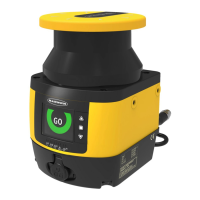The following application examples should be considered just as references for instructional purposes.
Stationary Area Guarding (Horizontal Danger Zone Guarding)
Area Guarding uses a horizontal sensing field (i.e., Safety or Warning Zones) to continually sense an individual within a
safeguarded area. Area Guarding can reduce or eliminate the possibility of a pass-through hazard that could result in an
individual being exposed to unexpected machine startup or motion.
As an individual approaches, the Warning Zone (the green area) can illuminate a warning beacon or sound an alarm that the
Safety Zone (the red area) is about to be entered. In conjunction with markings on the floor, the use of a Warning Zone can
eliminate intermittent stopping due to individuals being unaware of the safeguarded area. When the Safety Zone is
encroached upon, a stop is issued and the hazard is brought to a safe state.
Figure 4. Horizontal stationary area guarding
Typical considerations for horizontal stationary area guarding:
• In this example, the SX5 is mounted in the center of the operator work station to maximize the available size of the
Safety and Warning Zones. The SX5 is mounted directly to the cell's perimeter guarding fencing 300 mm above the
floor
to prevent crawling under the Safety Zone.
• In this example, physical damage is not expected because the fencing provides adequate protection. If interference
with the operator is expected, the Scanner can be recessed into the fencing to minimize exposure.
• The typical manufacturing setting is well within the SX5's environmental ratings.
• The size and coverage of the Safety Zone must ensure that the hazard cannot be accessed by moving (reaching)
around, under, or over the Safety Zone. Access to the hazard is prevented by the fencing along the side of the
Safety Zone, which minimizes the required floor space.
•
For this example, assume a robot stopping time of 100 ms, SX5 response time of 62 ms, the response time of a
safety interfacing device is 25 ms (UM-FA-9A safety module). Because an individual can reach over the detection
plane by bending at the waist, the Dpf adder is equal to 1200 mm (U.S. formula) and the Measurement Tolerance
Factor (Z
SM
) must be accounted for. This gives a safety distance of:Ds = 1600 mm/s × (0.1s + 0.062s + 0.025s)
+ 1200 mm + 150 mm = 1649 mm (64.9 in). In other words, the leading (outside) edge of the Safety Zone must be
1649 mm from the nearest hazard.
• It is recommended to mark the boundary of the Safety/Warning Zone on the floor.
• This example has no factors that would require an increase in the safety distance.
•
There is no possibility of easily stepping, climbing or otherwise avoiding detection.
• Because there is no pass-through hazard, the SX5 can be configured for "automatic start/restart (reset)". However,
the machine control circuitry must be designed so that one or more initiation devices must be engaged (e.g. a
conscious act is required) to start the machine.
•
Further, any initiation devices (or reset switches) must comply with the Reset Switch Location.
• For the purpose of this example, the UM-FA-9A Universal Input Safety Module was used and interfaced in a control
reliable (category 3 or 4) method as described in the wiring diagram.
Stationary Area Guarding with Zone Set Switchover
An Area Guarding application can use the Zone Set Switchover function to automatically allow access to one area while
simultaneously guarding another hazardous area. This can improve machine cycle efficiency by allowing the operator to
remove/place parts while the operation is in a different area, for example.
SX5 Safety Laser Scanner
www.bannerengineering.com - Tel: +1.763.544.3164 11

